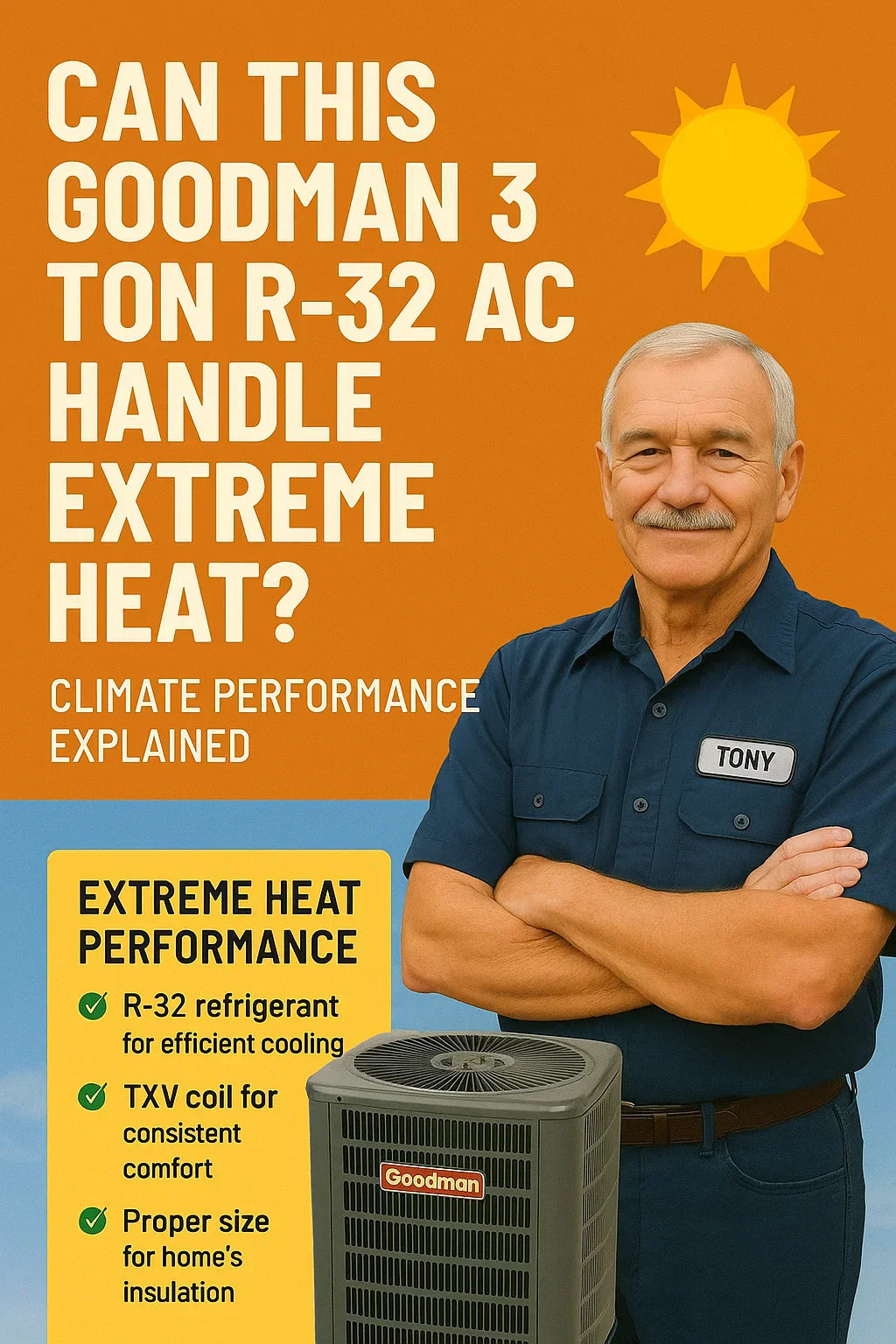When summer hits hard with 95–105°F heat, your air conditioner isn’t just about comfort — it’s about survival. But not every AC performs the same in extreme conditions.
I’m Tony, a homeowner who’s been through scorching summers in Texas and Florida. When I looked into Goodman’s 3 Ton 15.2 SEER2 R-32 AC system (GLXS4BA3610 condenser + CHPTA4230C3 TXV coil), my main question was simple:
👉 Will this system keep my house cool when the mercury pushes past 100°F?
This guide breaks down how Goodman’s 3 Ton R-32 system performs in extreme heat, what factors matter most, and whether it’s the right choice for homes in hot, humid, or desert-like climates.
☀️ Why Climate Performance Matters
Not all AC units are created equal. Systems are rated in labs at standard conditions (95°F outdoor temp) — but in real life, many regions push far hotter.
-
Desert climates (Arizona, Nevada): Temps often exceed 105–110°F.
-
Humid climates (Florida, Texas): Temps stay high with brutal humidity.
-
Heatwaves (Midwest, Northeast): Even mild regions are seeing record highs.
As the outdoor temp rises:
-
Cooling capacity drops (the system works harder to move heat).
-
Run times get longer.
-
Energy use spikes.
-
Comfort can suffer if the system is undersized.
📖 Source: DOE – Central AC and Climate
Tony’s note: “I’ve had ACs that were fine at 90°F but gave up at 102°F. That’s why I wanted to know if Goodman’s 3 Ton can really handle the heat.”
⚙️ How the Goodman 3 Ton R-32 AC Works in High Heat
The Goodman 3 Ton R-32 system delivers 36,000 BTUs per hour under standard conditions. But performance in the real world depends on refrigerant type, coil design, and installation.
Why R-32 Matters in Extreme Heat
-
Higher efficiency than R-410A in hot conditions.
-
Handles pressure better, meaning the compressor works less hard.
-
Environmentally friendly (lower global warming potential).
TXV Coil Advantage
The Thermostatic Expansion Valve (TXV) ensures refrigerant flow adjusts with demand. In extreme heat, this prevents coil flooding or starving, keeping efficiency stable.
Tony’s perspective: “That TXV coil is the secret weapon. It keeps my system steady, even when the sun is baking the roof.”
📊 SEER2 Ratings in Real-World Heat
Goodman’s 3 Ton R-32 system is rated 15.2 SEER2 — a solid efficiency level that balances cost and performance.
But here’s the catch:
-
SEER2 is measured at standard lab conditions (95°F outdoor).
-
At 100–105°F, efficiency drops.
-
A 15.2 SEER2 unit may operate closer to 12–13 EER equivalent in extreme heat.
Still, that’s more efficient than older R-22 or basic 13 SEER units.
📖 Source: Energy Star – Efficiency Ratings
Tony’s tip: “Don’t just buy on SEER2. Ask how the system handles your climate load. That’s the real test.”
🌡️ Cooling Capacity vs. Home Size in Hot Climates
A 3 Ton (36,000 BTU) AC generally cools 1,500–1,800 sq. ft. in average conditions. But in extreme heat, the “coverage” can shrink.
Factors That Reduce Effective Coverage in Hot Climates
-
Poor insulation or old windows.
-
Direct sun exposure (south- or west-facing rooms).
-
Large open layouts.
-
High occupancy (lots of body heat).
Example
-
In Ohio (avg. 85–90°F summers): A 3 Ton can handle a 1,700 sq. ft. home easily.
-
In Texas (100°F+ summers): That same 1,700 sq. ft. home might need a 3.5–4 Ton unit unless it’s well insulated.
📖 Source: ACCA – Manual J Load Calculations
Tony’s insight: “Square footage is just a starting point. My 1,600 sq. ft. home in Florida needed 3.5 Tons because of heat gain.”
💧 Humidity Control in High-Heat Regions
Humidity makes heat unbearable. Fortunately, Goodman’s R-32 system paired with a TXV coil excels here.
-
Single-stage systems: Cycle on/off quickly, less humidity removal.
-
Two-stage systems: Longer, lower cycles → more moisture pulled from the air.
-
TXV coil: Keeps refrigerant flow balanced, improving dehumidification.
Result: Your home feels cooler at the same thermostat setting.
📖 Source: Energy Star – Dehumidification Benefits
Tony’s comment: “In Florida, humidity was my real enemy. The Goodman with a TXV coil finally made my house feel cool, not clammy.”
🔧 Installation & Maintenance Factors for Extreme Heat
Even the best system fails if installed poorly. In extreme climates, details matter.
-
Ductwork: Undersized ducts choke airflow.
-
Refrigerant charge: R-32 requires precise levels — too much or too little kills efficiency.
-
Thermostat placement: Avoid sunny walls or attic areas.
-
Annual tune-ups: Cleaning coils, checking charge, and clearing drains prevents summer breakdowns.
📖 Source: ACCA – Proper Installation Guidelines
Tony’s rule: “The install matters more than the brand. A bad install will make any AC sweat.”
💵 Energy Costs in Hot Climates
How much will a 3 Ton Goodman 15.2 SEER2 cost to run in extreme heat?
-
Hot southern states (1,500 cooling hours/year): $1,000–$1,500 annually.
-
Mild northern states (700 cooling hours/year): $500–$700 annually.
How to Lower Costs
-
Seal and insulate ducts.
-
Use a programmable or smart thermostat.
-
Schedule tune-ups every spring.
-
Keep condenser shaded but not blocked.
Tony’s advice: “Invest in attic insulation — it cut my AC bills by 20%.”
🏡 Tony’s Guidance: Is the Goodman 3 Ton Enough?
So, can Goodman’s 3 Ton R-32 AC handle extreme heat?
👉 Yes, if your home is properly sized and insulated.
-
For a well-insulated 1,500–1,600 sq. ft. home in hot climates → The 3 Ton works.
-
For poorly insulated homes or open layouts → Consider a 3.5–4 Ton.
-
For humid regions → A two-stage Goodman model may offer better comfort.
Tony’s wrap-up:
“The Goodman 3 Ton R-32 isn’t just a lab number. It’s a real-world workhorse. But the secret is matching it to your home’s needs. Get the sizing right, and it’ll keep you cool even when it’s 105° outside.”
In the next topic we will know more about: Goodman Warranty Breakdown: What’s Covered (and What’s Not)







